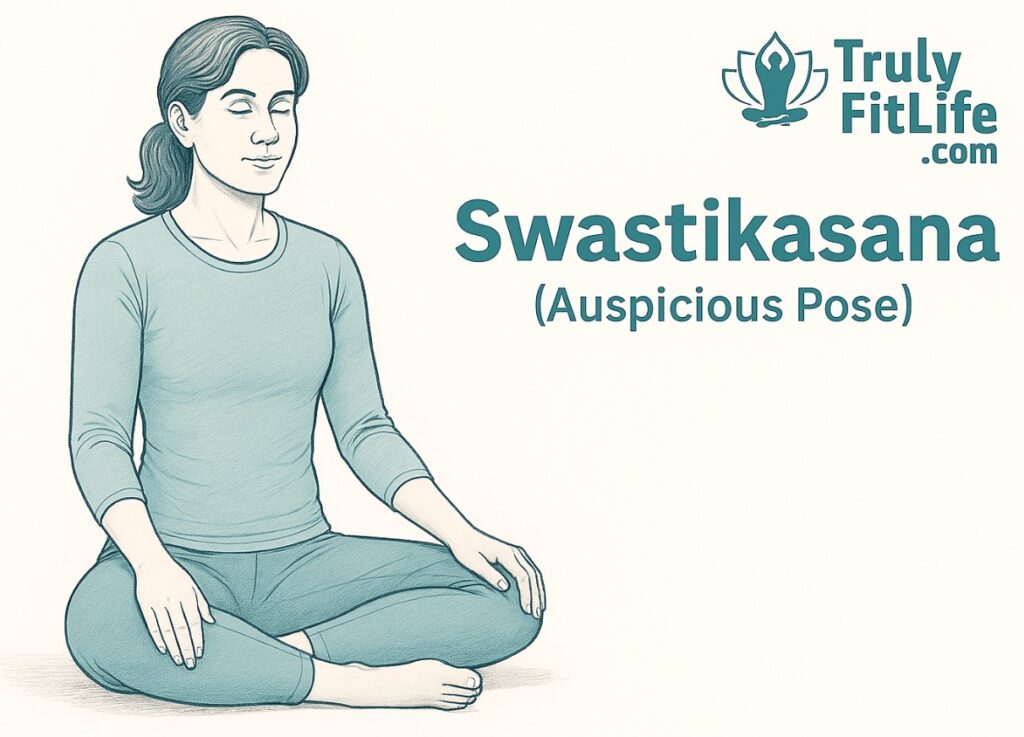
Swastikasana (Auspicious Pose) is a traditional seated posture described in classical yogic texts such as the Hatha Yoga Pradipika and Gheranda Samhita. The word “Swastika” in Sanskrit means auspicious, well-being, or prosperity. This pose symbolizes balance, stability, and inner harmony, making it a favored posture for meditation and pranayama.
Unlike more complex seated postures like Padmasana (Lotus Pose) or Siddhasana (Accomplished Pose), Swastikasana is beginner-friendly and places less strain on the knees and hips. It offers comfort and stability, allowing practitioners to focus on breath and meditation without distraction.
Step-by-Step Instructions to Practice Swastikasana – Auspicious Pose
1. Preparation
- Begin in Dandasana (Staff Pose) with legs extended straight forward.
- Keep spine tall and palms resting beside your hips.
2. Leg Positioning
- Bend the left leg and place the foot against the inner right thigh.
- Bend the right leg and tuck the foot into the space between the left calf and thigh.
- Both heels should press gently into the groin region.
3. Hand Placement
- Rest palms on knees in Jnana Mudra or Chin Mudra.
- Alternatively, rest hands on thighs for grounding.
4. Alignment
- Keep the spine upright, shoulders relaxed, and chest slightly lifted.
- Chin parallel to the ground, gaze forward or eyes gently closed.
5. Breathing
- Inhale deeply through the nose, expanding chest.
- Exhale slowly, softening facial muscles and shoulders.
6. Duration
- Beginners: Hold for 2–5 minutes.
- Experienced practitioners: Extend up to 20–30 minutes for meditation or pranayama.
Alignment Tips
- Use a folded blanket under hips if knees remain elevated.
- Avoid rounding the spine—keep the back tall.
- Change leg crossing after long holds to balance both sides.
Benefits of Swastikasana – Auspicious Pose
🦴 Physical Benefits
- Improves Posture: Promotes natural spinal alignment.
- Opens Hips & Groin: Gently stretches the thighs and pelvic muscles.
- Supports Digestion: Sitting upright benefits abdominal organs.
- Strengthens Back: Builds endurance in spinal and core muscles.
- Foundation for Meditation: Provides stability for long sitting practices.
🧘♂️ Mental & Emotional Benefits
- Promotes Calmness: Relieves stress and anxiety.
- Enhances Focus: Aids concentration during meditation or mantra chanting.
- Symbol of Auspiciousness: Represents positivity, well-being, and inner peace.
- Balances Energy: Encourages upward pranic flow through the spine.
Contraindications & Precautions
- ❌ Avoid if you have severe knee arthritis or hip injuries.
- ❌ People with chronic sciatica should use props or modify.
- ⚠️ Pregnant women should sit with support to avoid pressure on abdomen.
- ⚠️ Always release posture slowly to prevent strain in knees or ankles.
👉 Modification: Place yoga blocks or cushions under each knee for added comfort.
Modifications & Variations
- Supported Swastikasana: Sit on a folded blanket for elevation.
- Chair Meditation: Those with knee issues can practice mudras while seated on a chair.
- Dynamic Variation: Combine with gentle pranayama practices such as Anulom Vilom.
Drishti (Gaze Point)
- Nasagra Drishti (Tip of Nose): Enhances internal focus.
- Ajna Chakra Drishti (Third Eye): For deeper meditation.
Chakras Activated
- Muladhara (Root Chakra): Stability and grounding.
- Anahata (Heart Chakra): Emotional balance and calmness.
- Ajna (Third Eye Chakra): Intuition and clarity during meditation.
Practice Suggestions
- Practice in the morning or evening for meditation and breathwork.
- Ideal for mantra chanting, mindfulness, and relaxation practices.
- Beginners can alternate between Swastikasana and Sukhasana for comfort.
- Warm up with gentle hip stretches before long holds.